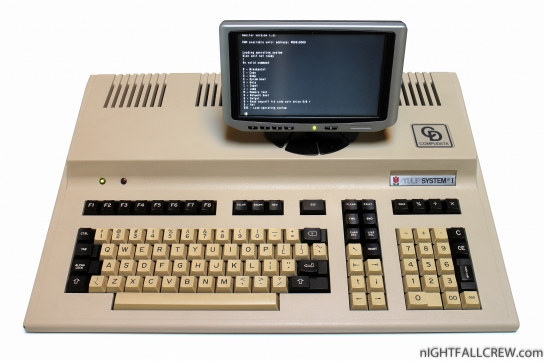Tulip Computers (CompuData) Tulip System 1

The Tulip system I was a 16-bit personal computer based on the Intel 8086 and made by Tulip Computers, formerly an import company for the Exidy Sorcerer, called CompuData Systems.
Its 6845-based video display controller could display 80×24 text in 8 different fonts for supporting different languages, including a (Videotex based) font for 2×3 pseudo graphic symbols for displaying 160×72 pixel graphics in text mode. The video display generator could also display graphics with a 384×288 or 768×288 (color) or 768×576 (monochrome) pixel resolution using its built-in NEC 7220 video display Coprocessor, which had hardware supported drawing functions, with a very advanced set of bit-block transfers, it could do line generating, arc, circle, ellipse, ellipse arc, filled arc, filled circle, filled ellipse, filled elliptical arc and many other varied commands.
Its memory could be upgraded in units of 128 KB up to 896 KB (much more than the 640 KB of the original PC).
It included a SASI hard disk interface (a predecessor of the SCSI-standard) and was optionally delivered with a 5 MB or 10 MB hard disk. The floppy disk size was 400 KB (10 sectors, instead of 8 or 9 with the IBM PC) or 800kb (80 tracks).
It ran at 8 MHz, almost twice the speed of the IBM PC XT which was launched only a few months earlier in July 1983. It had the possibility to use an 8087 coprocessor for math, which increased the speed to > 200 kflops, which was near mainframe data at that time.
After initially using CP/M-86 it quickly switched to using generic MS-DOS 2.00. There was a rudimentary IBM-BIOS-emulator, which allowed the user to use WordStar and a few other IBM-PC software, but Compudata B.V. shipped WordStar and some other software as adopted software for this computer. There was a programming support by Compudata B.V. with MS-Basic, MS-Pascal and MS-Fortran. On a private base, TeX and Turbo Pascal were ported to the Tulip System 1.
Gallery:
Works that i have made before power on the computer:
- Removing the filter capacitor inside the power supply.
- Replaced the tantalum capacitors.
- Eprom (ROM) dump.
- Found the pinout for the Video composite signal.
- Cleaning.
Pinout for the Video composite:
Download:
source: wikipedia
































As a Tulip 1 owner I have to say this page has been a life saver for me.
My unit was part of the former Romanian Institute for Research in Electronics (Institutul de Cercetari in Electronica – ICE), Iasi branch. My dad used to be a researcher there before ending up at Siemens. I had this computer since I was 5 but due to a missing PSU I only recently actually had the smarts required to improvise a replacement and boot it up.
Unfortunately the EPROM ROM has suffered from bit rot and the MS-DOS it had on memory is unbootable.
I noticed you have a ROM dump attached here but there are multiple files and I have no idea which is which or how would I be supposed to flash them on a new EPROM memory.
If somehow someone manages to read this message, I’d really like to know how I could flash a new EPROM from those files so I could actually get the Tulip to boot into an operating system.
Drinks on me if I ever get the chance!
PS: tried registering on the BBS as a new user but it kept telling me that the new password is incorrect (??)